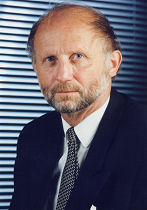أكيم مولر (بالألمانية: Achim Müller) هو كيميائي ألماني، ولد في 14 فبراير 1938 في دتمولد في ألمانيا.[6][7][8]
| أكيم مولر | |
|---|---|
| (بالألمانية: Achim Müller) | |
| معلومات شخصية | |
| الميلاد | 14 فبراير 1938 (82 سنة) دتمولد[1] |
| مواطنة |  ألمانيا ألمانيا |
| عضو في | الأكاديمية الألمانية للعلوم ليوبولدينا، والأكاديمية الأوروبية[2]، والأكاديمية الأوروبية للعلوم والآداب، والأكاديمية البولندية للعلوم[3]، وأكاديمية العلوم الوطنية الهندية |
| الحياة العملية | |
| المدرسة الأم | جامعة غوتينغن |
| المهنة | كيميائي[4]، وأستاذ جامعي |
| اللغات | الألمانية[5] |
| مجال العمل | كيمياء لاعضوية |
| موظف في | جامعة دورتموند للتكنولوجيا، وجامعة بيليفيلد |
مراجع
- وصلة : https://d-nb.info/gnd/128622024 — تاريخ الاطلاع: 10 ديسمبر 2014 — الرخصة: CC0
- https://www.ae-info.org/ae/User/Müller_Achim
- http://czlonkowie.pan.pl/czlonkowie/sites/WynikiWyszukiwania.html?s=M%C3%9CLLER,%20Achim — تاريخ الاطلاع: 26 مارس 2019
- وصلة : https://d-nb.info/gnd/128622024 — تاريخ الاطلاع: 25 يونيو 2015 — الرخصة: CC0
- http://data.bnf.fr/ark:/12148/cb12280741z — تاريخ الاطلاع: 10 أكتوبر 2015 — الرخصة: رخصة حرة
- a) Supramolecular Inorganic Chemistry: Small Guests in Small and Large Hosts, A. Müller, H. Reuter, S. Dillinger, Angew. Chem. Int. Ed. Engl., 1995, 34, 2328; b) Induced molecule self-organization, A. Müller, Nature, 1991, 352, 115; c) The Taming of the Shrew: Studying the Interaction of Ions with Ionic Carcerands as Molecular Containers, A. Müller, E. Diemann, E. Krickemeyer, Naturwissenschaften, 1993, 80, 77. Müller’s work on a new type of isopolyoxovanadates has provided some of the most instructive examples of host-guest inorganic chemistry, leading to the recognition that a polyoxometalate is a supramolecular species involving a negatively charged host cage and a negatively charged encapsulated guest, and hence opening a new era in polyoxometalate chemistry. The template self-organization of an ”electronically inverse host” around a negatively charged guest might seem somewhat puzzling: According to theoretical studies, this follows from the fact that electrostatic repulsion is overcome by maximizing the molecular electrostatic potential at the guest; see also From Lindqvist and Keggin ions to electronically inverse hosts: Ab initio modeling of the structure and reactivity of polyoxometalates, M.-M.Rohmer, M. Bénard, J.-P. Blaudeau, J.-M. Maestro, J. M. Poblet, Coord. Chem. Rev. 1998, 178-180, 1019.
- a) From linking of metal-oxide building blocks in a dynamic library to giant clusters with unique properties and towards adaptive chemistry, A. Müller, P. Gouzerh, Chem. Soc. Rev., 2012, 41, 7431; b) Capsules with Highly Active Pores and Interiors: Versatile Platforms at the Nanoscale, A. Müller, P. Gouzerh, Chem. Eur. J. (Concept), 2014, 20, 4862.
- a) Iron-Only Nitrogenase: Exceptional Catalytic, Structural and Spectroscopic Features, in: Catalysts for Nitrogen Fixation: Nitrogenases, Relevant Chemical Models, and Commercial Processes, K. Schneider, A. Müller (Eds.: B. E. Smith, R. L. Richards, W. E. Newton), Kluwer, Dordrecht, 2004, p. 281; b) Towards Biological Supramolecular Chemistry: A Variety of Pocket-Templated, Individual Metal Oxide Cluster Nucleations in the Cavity of a Mo/W-Storage Protein, J. Schemberg, K. Schneider, U. Demmer, E. Warkentin, A. Müller, U. Ermler, Angew. Chem. Int. Ed., 2007, 46, 2408; corrigendum: Angew. Chem. Int. Ed., 2007, 46, 2970.
وصلات خارجية
- لا بيانات لهذه المقالة على ويكي داتا تخص الفن
